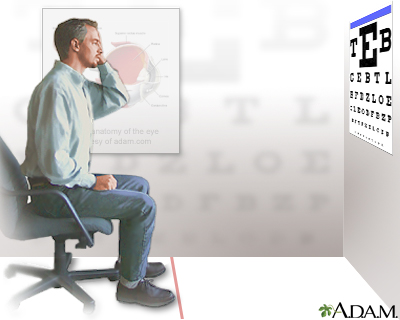Astigmatism
Astigmatism is a type of refractive error of the eye. Refractive errors cause blurred vision. They are the most common reason why a person goes to see an eye professional.
Other types of refractive errors are:

Astigmatism is a type of refractive error of the eye. People are able to see clearly because the front part of the eye (cornea) is able to bend (refract) light and focus it onto the retina. If the light rays are not clearly focused on the retina, the images you see may be blurry. With astigmatism, the cornea is abnormally or unevenly curved. This curve causes vision to be out of focus. Astigmatism can be corrected with glasses or contact lenses, or cured with laser surgery.

Visual acuity tests may be performed in many different ways. It is a quick way to detect vision problems and is frequently used in schools or for mass screening. Driver license bureaus often use a small device that can test the eyes both together and individually.
Causes
People are able to see because the front part of the eye bends (refracts) light and focuses it on the retina. This is the inside of the back surface of the eye.
If the light rays are not clearly focused on the retina, the images you see may be blurry.
With astigmatism, the cornea is abnormally curved. This curve causes vision to be out of focus.
The cause of astigmatism is unknown. It is most often present from birth. Astigmatism often occurs together with nearsightedness or farsightedness. If astigmatism gets worse, it may be a sign of keratoconus.
Astigmatism is very common. It sometimes occurs after certain types of eye surgery, such as cataract surgery.
Symptoms
Astigmatism makes it hard to see fine details, either close up or from a distance.
Exams and Tests
Astigmatism is easily diagnosed by a standard eye exam with refraction test. Special tests are not required in most cases.
Children or adults who cannot respond to a normal refraction test can have their refraction measured by a test that uses reflected light (retinoscopy).
Treatment
Mild astigmatism may not need to be corrected.
Glasses or contact lenses will correct astigmatism, but do not cure it.
Laser surgery can help change the shape of the cornea surface to eliminate astigmatism, along with nearsightedness or farsightedness.
Outlook (Prognosis)
Astigmatism may change with time, requiring new glasses or contact lenses. Laser vision correction can most often eliminate, or greatly reduce astigmatism.
Possible Complications
In children, uncorrected astigmatism in only one eye may cause amblyopia.
When to Contact a Medical Professional
Contact your health care provider or ophthalmologist if vision problems worsen, or do not improve with glasses or contact lenses.
References
Le NT, Mamalis C, Weikert MP, Al-Mohtaseb Z. Excimer laser surface ablation: photorefractive keratectomy (PRK), laser subepithelial keratomileusis (LASEK), and Epi-LASIK. In: Yanoff M, Duker JS, eds. Ophthalmology. 6th ed. Philadelphia, PA: Elsevier; 2023:chap 3.3.
Olitsky SE, Marsh JD. Abnormalities of refraction and accommodation. In: Kliegman RM, St. Geme JW, Blum NJ, et al, eds. Nelson Textbook of Pediatrics. 22nd ed. Philadelphia, PA: Elsevier; 2025:chap 660.
Stevens DV, Young JA. Correction of refractive errors. In: Yanoff M, Duker JS, eds. Ophthalmology. 6th ed. Philadelphia, PA: Elsevier; 2023:chap 2.4.
Version Info
Last reviewed on: 7/9/2024
Reviewed by: Audrey Tai, DO, MS, Athena Eye Care, Mission Viejo, CA. Also reviewed by David C. Dugdale, MD, Medical Director, Brenda Conaway, Editorial Director, and the A.D.A.M. Editorial team.
